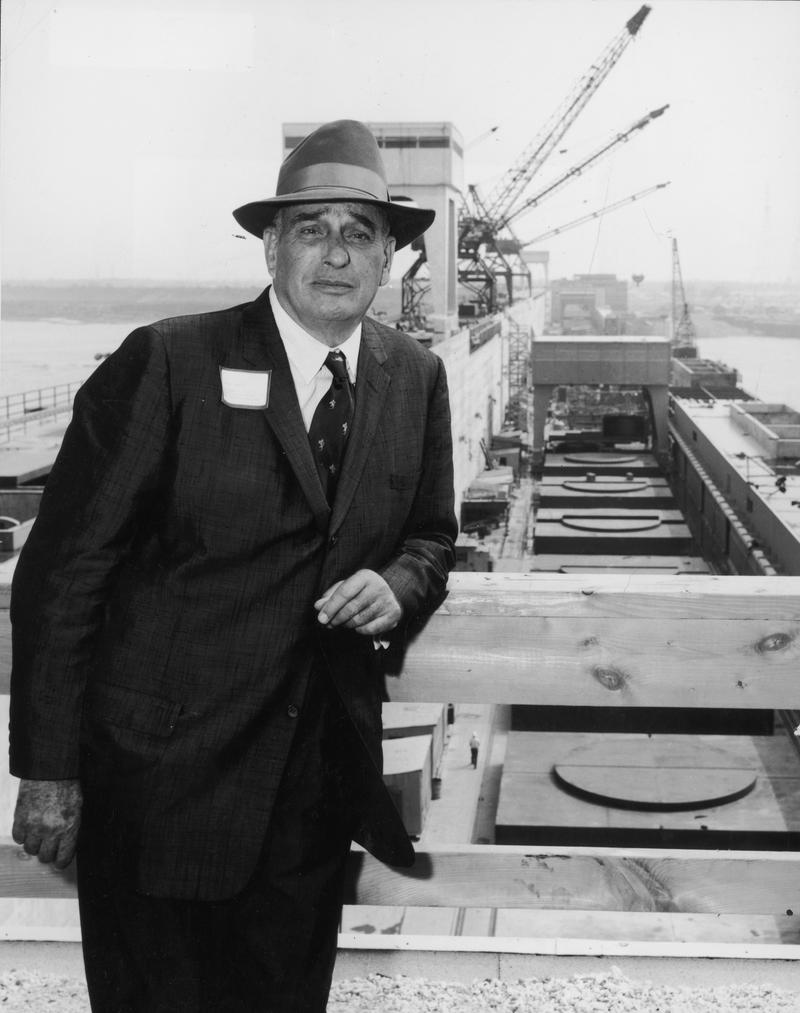A Conflicted Portrait of Robert Moses,'The Builder for Democracy'

"I'm not an author. I'm merely a victim" is the unwittingly prescient opening statement from Robert Moses at this 1952 Books and Authors Luncheon.
The book Moses references in his talk is not, of course, Robert Caro's The Power Broker: Robert Moses and the Fall of New York (1974), which indelibly fixed Moses's reputation as the man who destroyed neighborhoods, ignored mass transit, and precipitated the "white flight" to the suburbs that almost brought the city down in the 1960s. He is referring instead to the just-published, adulatory Robert Moses: Builder for Democracy (1952), by his friend Cleveland Rodgers.
Moses devotes most of his talk to lamenting the atmosphere of distrust that has arisen around government, the result of "altogether too many newspapers" conducting too many investigations. He insists that most of the state and municipal functionaries he deals with are "honest, hard-working, and interested in their job." He likes how Rodgers' book shows how things get done at the time, not with an "ex post facto brightness." Moses goes on to paint a somewhat dire picture of the city's future, in which traffic, safety, housing, and transportation will all be threatened by rising population. Tellingly, he looks forward to the time when "conditions get so bad that people have to entrust somebody with ability and experience and courage with the job of straightening the thing out." He concludes with a paean to the concept of public service, and again, perhaps unintentionally defending himself against the storm of criticism he was to face in later life, tells the audience "…don't be too critical of those of us who are trying our best in this particular vineyard."
Robert Moses was born in 1888. His ideas for reforming government attracted the attention of Al Smith, under whose patronage Moses rose to become a notable figure in New York state politics. Although neither an architect nor a builder, Moses became such an expert at drafting bills that were able to get through the state legislature that he soon accrued a vast amount of power; with the coming of the New Deal and its vast public works projects, Moses found himself in the perfect position to take advantage of federal largesse. Among his early accomplishments were the creation of Jones Beach, the New York parkway system (which opened up vast swathes of Long Island to motorists), and the Triborough Bridge (now called the Robert F. Kennedy Bridge). These and other projects not only profoundly reshaped New York City, but served as a template for the nation as a whole. As Paul Goldberger, architecture critic for The New York Times, wrote in Moses's obituary:
Although he disdained theories, he was a major theoretical influence on the shape of the American city, because the works he created in New York proved a model for the nation at large. His vision of a city of highways and towers -- which in his later years came to be discredited by younger planners -- influenced the planning of cities around the nation. His guiding hand made New York, known as a city of mass transit, also the nation's first city for the automobile age. Under Mr. Moses, the metropolitan area came to have more highway miles than Los Angeles does; Moses projects anticipated such later automobile-oriented efforts as the Los Angeles freeway system.
These early achievements, gained at the expense of rich landowners and corrupt politicians, made Moses into something of a folk hero. Perhaps the height of his popularity came with the 1939 World's Fair, in which his masterful handling of logistics, politics, and construction all came into play. Writing for The Atlantic at the time, Rodgers painted a typically sympathetic portrait of Moses:
In a period of prodigious public expenditures, Robert Moses emerges as the most farsighted and constructive of public spenders. He has demonstrated in brilliant fashion that democracy can be made to work by skillful, resolute handling, and that 'public improvements' can be given a surprising amount of beauty.
But after World War II, Moses's autocratic style, his emphasis on the automobile over mass transit, and his proclivity towards razing "slums" and replacing them with huge impersonal towers dominating vacant windswept squares caused a groundswell of reaction. As the city's fortunes deteriorated, he was accused of racism, of destroying neighborhoods, and of ruining municipal finances, and was even blamed for the departure of the Brooklyn Dodgers and New York Giants baseball teams. This time his enemies were not the rich and corrupt, but community activists and urban preservationists. An attempt to recapture some of his former glory with the 1964 World's Fair failed, and in 1974, Caro's majestic 1,246-page biography presented quite a different picture than that offered by Moses's friend Rodgers. This meticulously researched, excoriating attack fit in perfectly with the sense that New York City had taken a fatefully wrong turn. It was critically acclaimed and, despite Moses's outraged denunciations, won the Pulitzer Prize and the Francis Parkman Prize. Seldom has one book so decisively influenced its subject's reputation.
Recently, though, there has been a movement to recognize Moses's body of work, especially in the face of the seeming impossibility of the city ever being able to initiate any sort of public works project. As The New York Times reported in 2007:
That Moses was highhanded, racist, and contemptuous of the poor draws no argument even from the most ardent revisionists. But his grand vision and iron will, they say, seeded New York with highways, parks, swimming pools, and cultural halls, from the Belt Parkway to Lincoln Center, and thus allowed the modern city to flower.
Moses, who died in 1981 at the age of 92, remained unrepentant. "Those who can, build," he said. "Those who can't, criticize."
Audio courtesy of the NYC Municipal Archives WNYC Collection.
